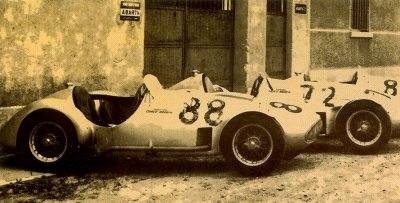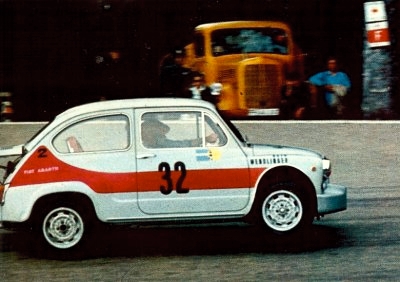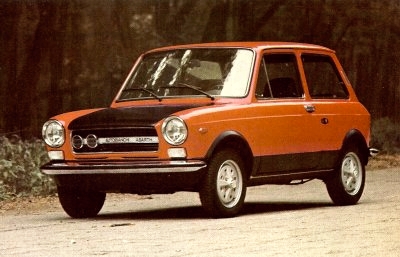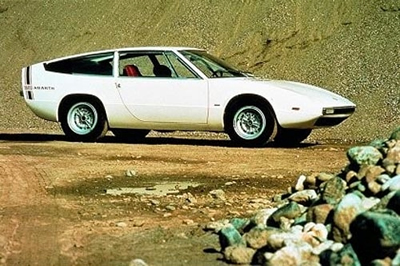Abarth
|
1949
- |
Country: |
 |
|
Carlo Abarth (aka 'the Wizard')
They called Carlo Abarth 'the Wizard'. His secret was, however, neither magic nor miracle, simply wise refinement and careful tuning. Two dates span the history of Abarth: founded by Carlo Abarth on 15 April 1949, it was absorbed in July 1971 by Fiat, with which the little Turin company had collaborated closely for over 20 years.
The background to the company is easily outlined. Immediately after the war Carlo Abarth, who came from Yugoslavia, settled himself in Merano in the Dolomites, where his family had originated, and established business contacts with one Rudolf Hruska.
Ferry Porsche, son of
Ferdinand Porsche (the designer of the
Volkswagen), invited Carlo Abarth, who was a friend of the family, to represent Porsche Konstruktionen of Stuttgart in Italy. It was through this offer that Abarth and Hruska were able to make contact with the major Italian car manufacturers.
They were also given the task of finding an Italian industrialist willing to manufacture or subsidize a Formula One (super-charged 1.5 litre single-seater) racing car designed by Ferdinand Porsche. It closely resembled the car devised by Porsche for Auto Union in 1933 in that it was rear engined; but its most original design point was that it featured four-wheel drive.
Tazio Nuvolari, an old Italian acquaintance of Abarth and one of the greatest drivers of all time, forged the initial link between Abarth and Hruska by discussing their project with a Turin industrialist, Piero Dusio, who numbered among his interests the
Cisitalia company, which manufactured racing cars. That was the beginning of the
Cisitalia-
Porsche collaboration. Initially, it was proposed to build not only a Formula One single-seater, but also a 2 litre GT saloon car, an all-purpose 11hp tractor and a small turbine.
But Piero Dusio ran into serious financial difficulties and, in 1949, moved to the Argentine taking with him the Formula One single-seater. After this the Cisitalia project died, but out of the collapse Abarth and Co was born. Carlo Abarth set up in business once again, this time in partnership with Armando Scagliarini, father of Guido Scagliarini, a well known
Cisitalia driver. The. badge of the new firm was the Scorpion - Carlo Abarth's sign of the zodiac.
Although Abarth began operations by participating in races with 1100 cc two-seater cars developed by
Cisitalia, the company soon began producing prototypes of its own. Carlo Abarth's knowledge and technical intuition were not backed by academic engineering qualifications. A typical self-made and practical man, Carlo Abarth was born with a natural mechanical ability. The first cars built by this remarkable man featured such items as backbone frames in large section elliptical tubing, flexibly mounted radiators, and readily detachable front suspensions, all of which were typical of the company and indicative of the intuitive skill of their designer.
The Cisitalia 1100, developed and prepared in the new works in via Trecate, confirmed their design promise by taking first, second, and third places in the 1949 race at Senigallia, driven respectively by Taruffi, Macchieraldo and Scagliarini. The first year during which Abarth was his own master ended with 18 victories for his cars. The production of silencers or
exhaust mufflers, which in the end became one of the basic and most profitable interests of the company, grew out of Abarth's desire to create an activity which would support the racing and experimental programme. What set him on this path was the notorious failure of one of his cars, the 204, in the 1949 Madrid GP.
Abarth Silencers and Manifolds
At that time racing engines were run on alcohol-based fuel, which Carlo Abarth was particularly adept at exploiting. But at Madrid, even during practice, it was obvious that the 204 was markedly inferior in terms of performance to the
Simcas and the Oscas. This completely unexpected set-back was later attributed to the possibility of the deterioration of the fuel in transit from Italy to Spain, but the repercussions on the company were immediate and a number of customers who had 204S on order cancelled. Obviously, the time had come to create another source of income and Carlo Abarth remembered that he had made his first silencer in 1928 when he was racing motor cycles.
His second was made in 1949. Devised to fit the most popular cars of the period, including non-Italian ones, the Abarth range of silencers was favourably received. Soon after, manifolds were added to the line and these were followed by
valves, valve springs and, in order to meet a fashion emanating from the United States, gearboxes with
steering column shift levers.
In the history of the company its second year of activity, 1950, was particularly important. At the
1950 Turin Show the 204 Berlinetta was introduced. Fiat-based, with a four-cylinder OHV engine of 1,090 cc, it featured magneto ignition, and twin carburettors on a special manifold.
 The Cisitalia 1100's, developed by Abarth at the via Trecate works in Turin, took the first three places in the 1949 Senigallia race.
The Cisitalia 1100's, developed by Abarth at the via Trecate works in Turin, took the first three places in the 1949 Senigallia race.
 A Fiat Abarth 1000 in action. The rear bonnet was held open (just visible) to keeo the 80bhp 982cc engine cool. The 1000 was fitted with a five-speed gearbox.
A Fiat Abarth 1000 in action. The rear bonnet was held open (just visible) to keeo the 80bhp 982cc engine cool. The 1000 was fitted with a five-speed gearbox.
 The Abarth modification of the Autobianchi 112 meant it could produce 58 bhp at 6600 rpm - enough to give the car a maximum speed of 95 mph.
The Abarth modification of the Autobianchi 112 meant it could produce 58 bhp at 6600 rpm - enough to give the car a maximum speed of 95 mph.
 The Fiat Abarth 2000cc special coupe with the Pininfarina designed bodywork, was exhibited at the Brussels motor show in 1969.
The Fiat Abarth 2000cc special coupe with the Pininfarina designed bodywork, was exhibited at the Brussels motor show in 1969.
 1969 – Abarth 1600 (ItalDesign).
1969 – Abarth 1600 (ItalDesign). |
The Wizard
Into this model, which was capable of achieving 114 mph, Abarth incorporated many of Porsche's most advanced ideas including torsion bar type suspension. In 1950
Tazio Nuvolari won his last race, driving a 204 Spider in the Palerrno-Monte Pellegrino hill climb.
The 204 was the starting point of what was to become another fundamental activity in the expanding activities of Abarth - improving the performance and producing special versions of other manufacturers' series production cars. However, Carlo Abarth energetically denied the nickname of 'wizard' which the sporting press gave him as Abarth-modified cars became more and more successful.
He attributed his success to an ability to extract, mainly by increasing cubic capacity and performance, qualities from series production engines which the manufacturer was not willing or able to do.
In 1952, following the 205 (a luxury version of the 204 with
bodywork by Vignale), Abarth developed the 1500cc 2-seater which was based on the mechanical elements of the Fiat 1400. The
bodywork was designed by Scaglione and came to be appreciated as one of the more successful post-war
aerodynamic studies.
From 1955 onwards, having survived the initial setbacks, Abarth activity settled down and diversified into four distinct fields: special versions of mass production models, record-breaking cars, sports cars designed and produced entirely by the company, and the manufacture of silencers.
Pininfarina, Ghia, Zagato, Bertone, Boano, Allemano and Viotti
Taking advantage of the collaboration of such famous coachbuilders as
Pininfarina, Ghia, Zagato,
Bertone, Boano, Allemano and Viotti, and of the stylist Scaglione, Abarth produced a number of small series models - sometimes one-offs -derived mainly from Fiat cars.
The exceptions are represented by an Alfa Romeo coupe with the mechanical components of the Super, a Porsche Carrera in
1960 and later, between
1963 -
1964, the Abarth versions of the Simca 1500 and 1300.
In
1955 Fiat put the 600 into production. It was this model which Abarth used as the foundation of what was to become his most famous war-horse, initially developing the engine and increasing its capacity to 747 cc. It became the fashionable car for those seeking a car with sporting performance at a reasonable price. (
see: Fiat 500 Abarth review |
Fiat 500F Berlina Review, and Abarth specific reviews are available on the
Unique Cars and Parts USA site under
Abarth).
Out of this development was born the 850TC, for which a special agreement was reached with Fiat, which undertook to supply Abarth not only with incomplete cars, but with vehicles from which such components as the front brakes, crankshaft, carburettor and
exhaust system were removed, these being the items on which '
the 'special' version was based.
Further development resulted in the 1000 version. These two models, the 850TC and the 1000, won innumerable victories on circuits all over the world and a number of European Touring Class Championships. Later the Fiat-Abarth 595 and 695 followed, both of which took part, with success, in many national and international races.
Abarth's 113 international and five world records are almost worth a separate article in themselves. In this very specialized field of activity, which began in 1956 with a vehicle using a 750 cc engine derived from that of the 600, the Fiat-Abarth name became internationally famous.
In fact only two records, the quarter-mile and the standing 500 metres in Class E up to 2000 cc, were obtained with cars entirely of Fiat origin. Thanks to the exceptional drag characteristics of the specialized bodywork, manufactured either by
Pininfarina or by
Bertone or in some cases by Abarth itself, exceptional results were achieved in the record- breaking programme.
Four Valves Per Cylinder
Two records illustrate the strides made by Abarth: the 24-hour class G record (751-1100cc) was raised to 167.72 kph from 136.50 kph, while for the 72-hour record, the speed was raised to 186.68 kph from 139.46 kph. Another article could be devoted to the engines and prototypes produced by the company.
Abarth began work in this field in
1963 with a 1300 cc engine which was developed first into a 1600 and then later into a 2-litre unit. The 'four valve per cylinder' version of this engine became the company's most outstanding engine and in
1970 and
1971 the European Hill Climb Championship was won by Ortner using this 2000 cc Abarth engine.
In little more than 20 years of activity Abarth had achieved 7,402 victories, of which 6,409 were with cars in which the Abarth and Fiat names were linked, and 616 with Simca-Abarth vehicles. In
1967 Carlo Abarth produced a 6-litre, 12-cylinder engine producing 600 bhp at 6,800 rpm, intended to power a
prototype for the World Manufacturers' Championship. But the decision of the CSI to limit engine capacity for prototypes to 3 litres resulted in the abandonment of the project, even though it was already close to completion. After the 1st August 1971, Abarth & Co has been part of the Fiat industrial complex, although its structure and name remain unchanged.
Re-birth Under Famed Engine Designer Aurelio Lampredi
From that time on, Abarth became the racing department of Fiat, managed by famed engine designer Aurelio Lampredi. Some models built by Fiat or its subsidiaries Lancia and Autobianchi were co-branded Abarth, the most famous being the Autobianchi A112 Abarth. Abarth also prepared Fiat Group's rally cars like Fiat 124 Abarth and 131 Abarth. In the 1980s Abarth name was mainly used to mark performance Fiats like Fiat Ritmo Abarth 130 TC.
The name was almost forgotten in 1990s and in 2000s it was used like a trim/model level on FIAT cars, like the FIAT Stilo Abarth. In 2007 Fiat Automobiles SpA relaunched the brand with the Grande Punto Abarth and the Grande Punto Abarth S2000. The brand is to be seen as a separate division to the main Fiat brand in a similar way that the Renault Sport brand is to the mainstream Renault. After years of sports competing on the continent, competition organisers announced the launch of a new Abarth 500 GB series for 2010. The competition was to represent a new high profile sponsored race series, which was staged at Oulton Park, Cheshire, on 3–5 April 2010.
Building on the success of its namesake Italian and European series, the GB competition brought together a plethora of driver-talent from across the British Isles; including no less than four female entrants in Vicki Butler-Henderson, Fiona Leggate, Sarah Franklin and Cassey Watson. The GB series was developed by the competitors for the competitors; by the sponsors for the sponsors, and by the fans for the fans. All Abarth Asetto Corse cars are built in Turin, Italy, and are checked to the highest standards. They are also subject to a shakedown and test at the Fiat Group proving ground in Balocco.
Also see: Fiat 131 Abarth Rally |
Abarth 500 (USA Site) |
Abarth OT 1000 (USA Site) |
Abarth 1300 (USA Site) |
Abarth 131 Rally (USA Site) 


